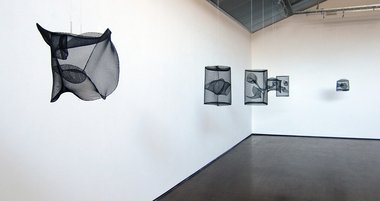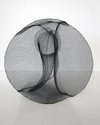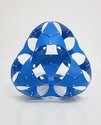John Hurrell – 19 December, 2013
With Corbelletto's mesh works, the flexibility of the material (its holding power) varies according to its size, and unless the artist finds a range of other tougher, related meshes to experiment with, the sculptures can't be made a lot larger than the versions shown in the gallery. These, because of the moiré effect of the netting, have an optically wild, significantly unstable quality to their surface, a shimmering that makes the form quiver as if breathing.
Chiara Corbelletto’s show here at Bath Street is a mixture of an older style of sculpture where soft polypropylene starlike modules join together (using tiny plastic bolts) to form overtly mathematical configurations, and a newer form of investigation that uses stitched wire mesh to make shimmering (moiré) forms you can look through - with floating finger or egg forms that are more organic and spontaneous in mood.
Her polypropylene sculptures are intellectually interesting, but only up to a point, with a folding over or under of co-joined modules, and an inventive interaction between two contrastingly coloured forms - drawing out skeletal forms that are more peep-through ‘hole’ than solid. However they are severely limited by their programmatic ethos. They end up being dry diagrams created by some obsessive hyperactive scientist, while the new grey mesh works on the other hand have a jellyfish, or cloudlike feel, so that their transparency effortlessly grips the mind, yanking it into unanticipated multiple associations. Their undulating spatial depth and delicate smudgy edges really help transport you.
The funny thing is I have always been a huge admirer of Sol LeWitt’s ‘linear/skeletal’ cube sculptures with their simple driving ideas but complex visual results. On initial reflection you’d think Corbelletto’s polypropylene sculptures would be related to LeWitt’s modular geometry, but not at all. For me there is too much surface and not enough intricacy. The mesh works however are related, not by concept (obviously) but through spatial similarities: their netlike ambience and evanescent quality of form. They also have similarities with LeWitt’s early pencil wall drawings which I also adore, fields which though flat, are extremely netlike - as if huge screens of rendered mesh - although determined by verbally articulated systems.
With Corbelletto’s mesh works, the flexibility of the material (its holding power) varies according to its size, and unless the artist finds a range of other tougher, related meshes to experiment with, the sculptures can’t be made a lot larger than the versions shown in the gallery. These, because of the moiré effect of the netting, have an optically wild, significantly unstable quality to their surface, a shimmering that makes the form quiver as if breathing. This brings a restlessness, a tension, to the ‘grown’ organic objects not found in the more industrial looking, cut-out, modular sculptures.
Of the mesh Space Embryos, about half are pinned at their upper edge to the wall, a couple sit awkwardly on clear plastic stands on plinths, and the rest are suspended from lighting tracks by nylon line. The latter have small metal rings and plastic sheaths that attach the line to the mesh and which are a little distracting.
Their appeal comes from an intuitive, nonprogrammatic method of construction where improvisation is valued, even though there are some similarities with the polypropylene Organising Principles works, particularly in the use of reversal or flipping of forms inside out. It is not just the ‘user friendly’ references to nature and roving human imagination that draw you in, but the fact these sculptures could be graphite drawings. They have a wonderful sense of insubstantiality, a wispiness of form which - as I’ve mentioned - is almost as if it is made by lingering smoke or grainy but pellucid jelly. Quite special.
John Hurrell









 Two Rooms presents a program of residencies and projects
Two Rooms presents a program of residencies and projects Advertising in this column
Advertising in this column



This Discussion has 0 comments.
Comment
Participate
Register to Participate.
Sign in
Sign in to an existing account.